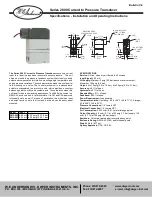
3
UHF Belt-Pack Transmitter
Rio Rancho, NM – USA
GENERAL TECHNICAL DESCRIPTION
The UM195B transmitter is comprised of a number of functional sub-systems as shown in the block diagram below.
The 195 system uses +/-75kHz deviation. The transmitter circuits are all regulated to allow full output power from the
beginning (9 Volts) to the end (7 Volts) of battery life. The oscillator crystal is shock mounted to provide ruggedness.
The input amplifier uses a Motorola 33078 op amp for ultra low noise operation. It is gain controlled with a wide range
input compressor which cleanly limits input signal peaks over 30dB above full modulation.
Traditionally, compandors have been a source of distortion in wireless microphone systems. The basic problem with
conventional systems is that the attack and decay times are always a compromise. If the time constants are fast, high
frequency transients will not be distorted, but this will cause low frequency distortion. If the time constants are slower,
low frequency audio distortion will be low, but high frequency transients will then be distorted. The 195 system
introduces an entirely new approach to solving this basic problem, called “dual-band companding.”
There are actually two separate compandors in the 195 system, one for high frequencies and one for low frequencies.
A crossover network separates the frequency bands at 1kHz with a 6dB per octave slope, followed by separate high
and low frequency compandors. The attack and release times in the high frequency compandor are fast enough to
keep high frequency transient distortion at a low level, and the low frequency compandor uses slower time constants,
reducing low frequency distortion to well below that of a conventional compandor.
High efficiency circuits throughout the design allow over 7 hours of operation using a single 9 Volt alkaline battery
(over 16 hours with a lithium 9V battery.) The battery compartment is a unique mechanical design which automati-
cally adjusts to fit any brand alkaline battery. The battery contacts are spring loaded to prevent “rattle” as the unit is
handled.
The UHF transmitter section uses a crystal stabilized main oscillator followed by a quadrupler and three doubler
stages. The crystal controlled frequency is extremely stable over a wide temperature range and over time. Double
tuning used in the multiplier stages provides higher attenuation of spurious emissions which, in turn, minimizes the
possibility that the transmitter RF output would interfere with another transmitter/receiver system operating in the
same vicinity.
At UHF frequencies, where wavelengths and antennas are shorter than VHF, a resonant dangling wire is preferred.
The antenna on the UHF version of the UM195B consists of a flexible ¼ wavelength wire, detachable via an SMA
connector. The impedance of this connector is 50 Ohms at UHF frequencies.
PWR
XTAL OSC
X4
X2
X2
X2
UHF TRANSMITTER
Vref
BASS
TREBLE
LP FILTER
HP FILTER
SET
LED
LIMIT
LED
COMPANDOR
Vreg
Vreg
+5VDC
+3.6VDC
SHUNT
LIMITER
INPUT
AMP
AUDIO
LEVEL
LP
FILTER
PEAK AUDIO
INDICATOR &
LIMITER
DRIVER
PILOT
TONE
OSC
5
4
3
2
1
MIC
JACK
+5V BIAS
SUPPLY
LF
ROLL-OFF
COMPANDED AUDIO
TO XMTR
COMPANDED
AUDIO
BUFFER
DELAY
+9VDC
PWR
LED
UM195B Block Diagram































